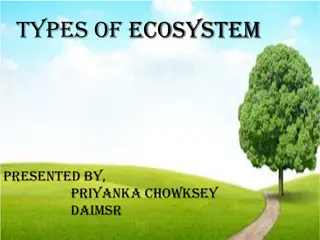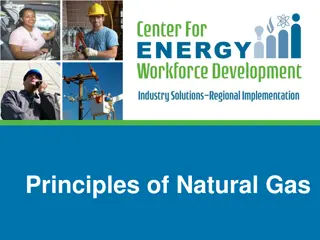Ecosystem Impacts of Natural Gas Development in Wyoming
Rapid energy development in Wyoming, particularly in the Atlantic Rim Natural Gas region, poses potential ecological challenges for rangeland species. The study focuses on predicting impacts of natural gas development on biodiversity and ecosystem services in the region, highlighting the need for careful management strategies to mitigate detrimental effects.
Download Presentation

Please find below an Image/Link to download the presentation.
The content on the website is provided AS IS for your information and personal use only. It may not be sold, licensed, or shared on other websites without obtaining consent from the author.If you encounter any issues during the download, it is possible that the publisher has removed the file from their server.
You are allowed to download the files provided on this website for personal or commercial use, subject to the condition that they are used lawfully. All files are the property of their respective owners.
The content on the website is provided AS IS for your information and personal use only. It may not be sold, licensed, or shared on other websites without obtaining consent from the author.
E N D
Presentation Transcript
The Ecosystem and Energy Development in Wyoming and the Intermountain West David Aadland, John Tschirhart & Alfredo Cisneros-Pineda (PhD Student) UW Department of Economics and Finance Milton Geiger UW Extension & School of Energy Resources Jacob Goheen UW Departments of Zoology/Physiology and Botany Berry Biodiversity Center
Overview Focus on ecological impacts from natural gas development Calibrate rangeland food web to Atlantic Rim Natural Gas (ARNG) region Introduce natural gas development and predict impacts on rangeland species
Introduction Rapid growth of energy development in Wyoming Unexpected consequences of human activity on Biodiversity Ecosystem Services: Hunting and Cattle Grazing
Atlantic Rim Natural Gas Development ARNG region is 109,297 hectares ARNG will contain 2,000 natural gas wells ARNG will produce 1.35 Tcf of natural gas (heat 1.93 million homes for one year) ARNG is home to many rangeland species Disturbance area (Buffer Zones) of 1,000 meters
Rangeland Ecosystem and GEEM Ecosystem contains many species (elk, deer, sage grouse, grasshoppers, prairie dogs, etc.) General Equilibrium Ecosystem Model (GEEM) Tschirhart (Journal of Theoretical Biology, 2000) GEEM is calibrated to ARNG region
General Equilibrium Ecosystem Model Plants & Animals act as if they were rational agents that maximize the net energy of Biomass Consumption (Hunting or Grazing) Benefits: Energy content in Biomass Grazing & Hunting Cost: Energy Expenditure Price Variable Cost: Respiration, Feces, Locomotion & Reproduction Energy content in Biomass vs Exposing to Predators & Respiration Cost
Optimal Management We use GEEM and Mathematica v 9.0 to predict: Impact on species populations of energy development activities Change in benefits for ecosystem services We consider two scenarios: 1. Hunting & Cattle Grazing 2. Hunting & Cattle Grazing + Buffer Zones
Where are we now? Write manuscript for publication Add other ecosystem externalities (e.g., land degradation from cattle grazing) Using GEEM to solve for natural steady state Adding migration corridors & spatial component Finding optimumextraction levels: hunting & cattle grazing























